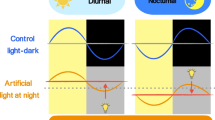Summary
1. The effects of ascorbic acid on uterine motility vary according to the condition of the uterus and to the hormone treatment to which it has been subjected.
2. The antagonism between oestradiol on one hand, and progesterone and testosterone on the other has also been proved, using ascorbic acid in vitro.
Similar content being viewed by others
References
Galamini, A. &Minozzi, M. T. - 1939 -Rend Ist. Sanit. publ. 2,389.
Kappeli, W. - 1940 -Helv. med. Acta 7,169.
Robson, J. M. &Sharaf, A. - 1951 -J. Endocrinology 7,177.
Rothlin, E. - 1941 -Schweiz. med. Wschr. 71,1308.
Sharaf, A. - 1951 - Mechanism of hormone antagonism Ph. D. Thesis presented to University of London.
Sharaf, A. - 1952 -J. Pharmaceut. Soc. (U.A.R.), 24,644.
Author information
Authors and Affiliations
Rights and permissions
About this article
Cite this article
Sharaf, A., Gomaa, N. Interrelationship between ascorbic acid and gonadal hormones as determined in vitro. Plant Food Hum Nutr 17, 248–253 (1969). https://doi.org/10.1007/BF01322230
Published:
Issue Date:
DOI: https://doi.org/10.1007/BF01322230




